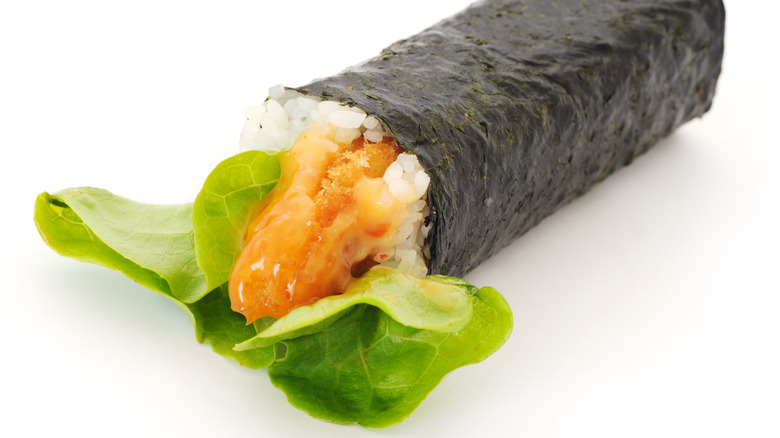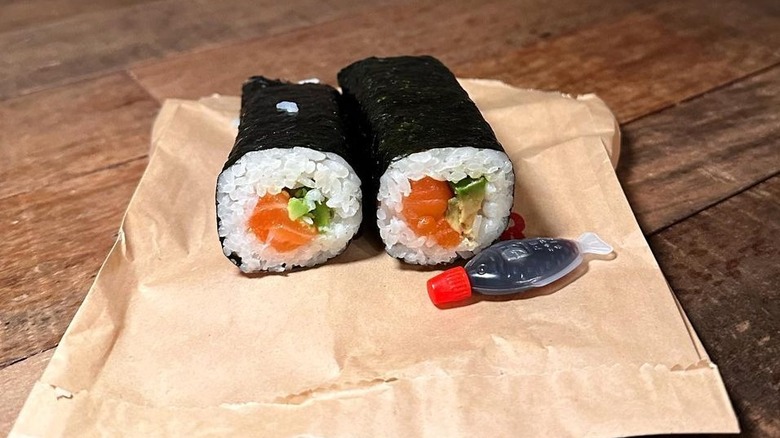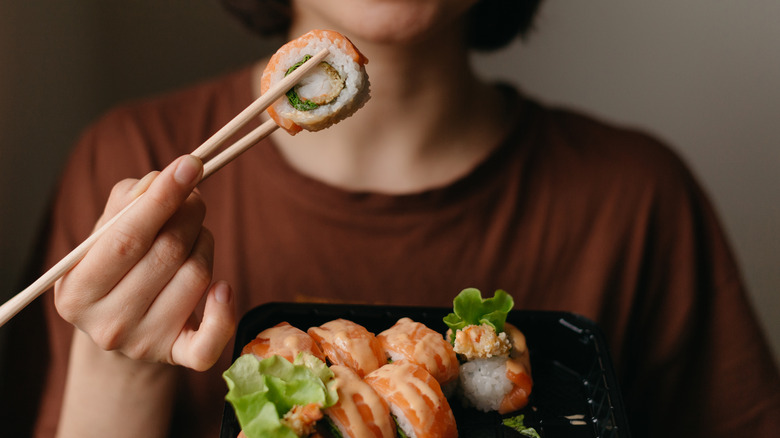What Is Australian-Style Sushi And How Do You Find It In The US?
Ever since Alex Marks went viral on TikTok for opening an Aussie-style sushi venue in the West Village — and sparking some online discourse in the process — America began to ask what exactly Australia's twist on sushi was and where they could find it.
@boujeebitesonly New aussie-style sushi rolls in the West Village that won't break the bank👏🏻🍣💸 📍@Sushi Counter #nycsushi #nycsushitakeout #nycsushispots #nycsushireviews #nycsushilovers #sushicounternyc #westvillage #westvillagenyc #westvillageeats #westvillagefood #westvillagefoodies #westvillagerestaurant #hiddengemsnyc #thingstodoinnyc #nycopening
Featuring thin, uncut rolls and very Australian fillings such as teriyaki chicken, Australian-style sushi borrows greatly from the country's fusion cuisine. Unsurprisingly, similar national Australian chains — like Shuji Sushi – cropped up in popularity over the decades in the land Down Under, featuring slim takeout handrolls that Marks' menu at Sushi Counter aims to recreate — down to the infamous teriyaki chicken option.
While trendy Australian cuisine like avocado toast has trickled into the American dining scene, purchasing Australian-style sushi becomes very difficult outside of Manhattan itself. Most sushi venues in the U.S., even the ones featuring fusion or takeout rolls, do not advertise themselves as Aussie-style, making Sushi Counter's cheap handrolls a rarity in both style and marketing.
Australia's sushi reflects its multicultural fast food cuisine
According to a 2019 public opinion study by Roy Morgan, an Australian market research company, Australians have shown an increased interest in both international cuisine as well as fast food over the past few years. In the 2010s, Roy Morgan reported that approximately one-fifth of surveyed Australians preferred quick-service Asian food venues, and Japanese cuisine in particular saw a large surge in popularity between 2014 and 2018.
These trends in Australian dining set the groundwork that made easily transportable Asian-styled cuisine like Sushi Counter's skinny handrolls, for example, take off in Australia and eventually abroad. This is a stark contrast to how most Western countries, particularly in Europe, treat sushi as a fine dining delicacy, meant to be eaten in fancy restaurants at an exorbitant price.
However, Australia's sushi offshoots are not unique to the country, as the U.S.'s similar taste for multicultural fast food gave rise to such creations as the sushi burrito in San Francisco. But if you want to try this easy-to-eat temaki, as of publication, you'll have to head straight to Sushi Counter on St Christopher Street in Manhattan — or make it yourself.
Sushi has a long-time history of being a cultural export
Japanese cuisine already had its version of convenient sushi, referred to as temaki, popularized as far back as the 19th century Edo period according to some scholars. Australian-style sushi, and, in particular, the Aussie-style sushi found at Sushi Counter, is less an original export of authentically Australian cuisine and more of a product of cultural diffusion. Non-western countries are no exception to the rule, with some scholars theorizing that Japan's occupation of Korea likely led to the invention of kimbap (though it is important to note that this is contentious and some argue kimbap evolved independently of Japan).
Sushi itself has a murky origin despite being generally accepted as part of traditional Japanese cuisine. Many historians argue that ancient Chinese or Southeast Asian cooks likely created a version of fermented sushi as far back as the fourth century. Even then, sushi only became popular in Japan, and eventually abroad, during the 20th century, taking on a variety of fillings and styles as it underwent globalization. So, one could argue that Australian sushi is simply another chapter in the dish's evolving history.



